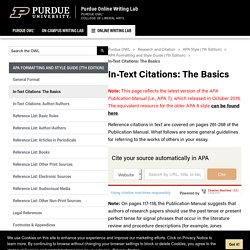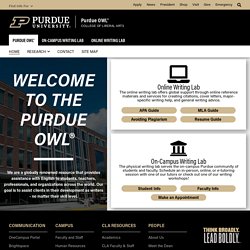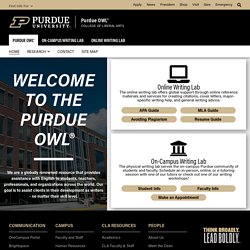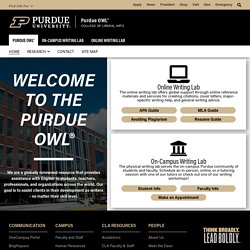

APA Formatting and Style Guide. This page is brought to you by the OWL at Purdue University.

When printing this page, you must include the entire legal notice. Copyright ©1995-2018 by The Writing Lab & The OWL at Purdue and Purdue University. All rights reserved. This material may not be published, reproduced, broadcast, rewritten, or redistributed without permission. Use of this site constitutes acceptance of our terms and conditions of fair use. Summary: APA (American Psychological Association) style is most commonly used to cite sources within the social sciences. Cite your source automatically in APA Powered by Reference citations in text are covered on pages 169-179 of the Publication Manual. Note: APA style requires authors to use the past tense or present perfect tense when using signal phrases to describe earlier research, for example, Jones (1998) found or Jones (1998) has found... APA citation basics When using APA format, follow the author-date method of in-text citation.
Short quotations Long quotations. OWL. Contributors:Allen Brizee.Summary: This resource outlines the generally accepted structure for introductions, body paragraphs, and conclusions in an academic argument paper.

Keep in mind that this resource contains guidelines and not strict rules about organization. Your structure needs to be flexible enough to meet the requirements of your purpose and audience. The following sections outline the generally accepted structure for an academic argument paper. Keep in mind that these are guidelines and that your structure needs to be flexible enough to meet the requirements of your purpose and audience. You may also use the following Purdue OWL resources to help you with your argument paper: Introduction The introduction is the broad beginning of the paper that answers three important questions: What is this? You should answer these questions by doing the following: First, I will define key terms for my argument, and then I will provide some background of the situation. Thesis checklist Induction. Self Assessment - For Students - Writing and Communication Center - UW Bothell. OWL: Creating a Thesis Statement. Summary: This resource provides tips for creating a thesis statement and examples of different types of thesis statements.

Contributors:Elyssa Tardiff, Allen BrizeeLast Edited: 2014-02-10 10:44:43 Tips for Writing Your Thesis Statement 1. Determine what kind of paper you are writing: An analytical paper breaks down an issue or an idea into its component parts, evaluates the issue or idea, and presents this breakdown and evaluation to the audience.An expository (explanatory) paper explains something to the audience.An argumentative paper makes a claim about a topic and justifies this claim with specific evidence. If you are writing a text that does not fall under these three categories (e.g., a narrative), a thesis statement somewhere in the first paragraph could still be helpful to your reader. OWL: Paraphrase Exercises. Summary: This resource discusses how to paraphrase correctly and accurately.

Contributors:Purdue OWLLast Edited: 2016-06-30 09:41:14 Learn to borrow from a source without plagiarizing. For more information on paraphrasing, as well as other ways to integrate sources into your paper, see the Purdue OWL handout Quoting Paraphrasing, and Summarizing. For more information about writing research papers, see our resource on this subject. A paraphrase is... your own rendition of essential information and ideas expressed by someone else, presented in a new form.one legitimate way (when accompanied by accurate documentation) to borrow from a source.a more detailed restatement than a summary, which focuses concisely on a single main idea.
Paraphrasing is a valuable skill because... 6 Steps to Effective Paraphrasing Some examples to compare The original passage: Students frequently overuse direct quotation in taking notes, and as a result they overuse quotations in the final [research] paper. APA Citation Examples - UMUC Library. Tools for Writing: Points of View in Writing. There are three different points of view that can be used in writing: first person, second person, and third person.

In academic writing, the third person point of view is usually clearer and allows a writer to come across as more credible. Due to this and other reasons, the third person point of view is considered the best in academic writing. First person occurs primarily through the use of the pronoun “I.” This is the point of view used when a writer is writing about himself. There may be times when it is okay to incorporate personal examples into an essay, and if so, the first person will be used. Second person involves the use of the pronoun “you” to refer to the reader. All beginning college students should learn how to write well. Notice the shift that occurred from the first sentence, which is written in the third person, to the second sentence, which is written in the second person. University of Oxford Podcasts - Audio and Video Lectures.